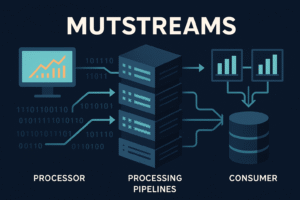In today’s hyper‑connected world, applications must process and react to data as it arrives. Mutstreams is a next‑generation streaming platform designed to ingest, process, and distribute millions of events per second with sub‑second latency. Whether you’re powering IoT networks, live media feeds, or real‑time analytics dashboards, Mutstreams provides the performance and reliability you need.
What Is Mutstreams?
Definition and Core Concept
Mutstreams is a distributed, fault‑tolerant event streaming platform that bridges the gap between data producers and consumers. Its core design focuses on:
- High Throughput: Handle massive message volumes without performance degradation.
- Low Latency: Deliver events in near real time, enabling instant reactions.
- Durability: Ensure no data loss through replication and persistence.
Evolution of Streaming Technologies
- Early Queues (e.g., RabbitMQ): Great for modest workloads but limited scaling.
- Distributed Logs (e.g., Apache Kafka): Introduced partitioned, replicated logs.
- Cloud‑Native Services (e.g., AWS Kinesis): Fully managed but often proprietary.
- Mutstreams: Combines on‑premises flexibility with cloud‑scale performance and open standards.
Key Features of Mutstreams
Real‑Time Data Ingestion
Mutstreams accepts incoming events from hundreds of thousands of producers and makes them available to consumers within milliseconds.
Horizontal Scalability
By simply adding broker nodes, you can grow your cluster seamlessly—no downtime required.
Fault Tolerance and Resilience
Automatic leader election and multi‑zone replication guarantee zero data loss, even if entire nodes or racks go offline.
Flexible Integration Options
Native connectors for databases (PostgreSQL, MongoDB), analytics frameworks (Spark, Flink), and cloud storage (S3, Azure Blob) allow you to extend Mutstreams into any ecosystem.
How Mutstreams Works
Architecture Overview
- Producers publish events to named topics.
- Brokers partition and replicate these topics across the cluster.
- Consumers subscribe to topics, reading from partitions in order.
H4: Producers and Brokers
- Producers buffer and batch messages.
- Brokers assign partitions and handle leader/follower roles.
H4: Consumers and Processing Pipelines
- Consumers maintain their read offset, enabling replay and precise control.
- Processing frameworks (Flink, Spark) can consume directly for stream processing.
Data Flow and Message Delivery
- Producer → Broker partition
- Broker replicates to follower nodes
- Consumer polls new messages in order
This design ensures consistency, replayability, and minimal end‑to‑end latency.
Benefits of Using Mutstreams
- Ultra‑Low Latency: Data is live in consumers within milliseconds.
- Elastic Capacity: Scale up or down with demand—no manual sharding.
- Built‑In Durability: Replication and disk persistence prevent data loss.
- Cost Efficiency: Pay‑as‑you‑grow pricing and open‑source community edition.
- Developer Productivity: SDKs in Java, Python, Go, .NET, and JavaScript.
Common Use Cases
IoT Sensor Networks
Collect and analyze telemetry from millions of devices in real time for predictive maintenance and alerting.
Live Media Delivery
Stream audio/video events with adaptive bitrate and global distribution.
Log Aggregation & Monitoring
Consolidate application logs into central dashboards for instant troubleshooting and anomaly detection.
Real‑Time Analytics Dashboards
Power BI and Grafana dashboards with live metrics for business insights.
Getting Started
Installation & Setup
- Download the Mutstreams package or Docker image.
- Configure
mutstreams.yaml(cluster nodes, replication factor). - Launch the broker processes: bashCopyEdit
mutstreams-server start - Verify cluster health: bashCopyEdit
mutstreams-cli cluster status
Basic Configuration Tips
- Choose an appropriate partition count to match your throughput needs.
- Set replication factor to at least 3 for production.
- Enable TLS for all inter‑broker and client communications.
Best Practices for Production
Security Hardening
- Enable ACLs to restrict access by client or application.
- Integrate with OAuth or Kerberos for authentication.
- Encrypt data at rest and in motion.
Performance Tuning
- Adjust batch.size and linger.ms settings on producers.
- Monitor GC pauses in JVM clients.
- Use SSD storage for broker logs.
Monitoring & Alerting
- Export metrics to Prometheus and visualize in Grafana.
- Alert on under‑replicated partitions, leader elections, and consumer lag.
Mutstreams vs. Alternatives
| Feature | Mutstreams | Apache Kafka | AWS Kinesis |
|---|---|---|---|
| Deployment Flexibility | On‑prem & Cloud | On‑prem & Cloud | Cloud‑only |
| Auto‑Scaling | Yes | Manual shards | Managed autoscale |
| Pricing Model | Usage‑based | Infrastructure | Per‑shard/hour |
| Ecosystem Integrations | Wide (OSS +) | Wide (OSS) | AWS services |
The Road Ahead
- Kubernetes Operator: Simplified cloud‑native deployments.
- Edge Streaming: Lightweight brokers for IoT gateways.
- AI‑Enhanced Streams: Built‑in anomaly detection and forecasting.
Conclusion
Mutstreams offers a modern, flexible approach to real‑time data streaming—combining the best of open‑source with enterprise‑grade features. From IoT and media streaming to log aggregation and analytics, it empowers organizations to build responsive, data‑driven applications at scale.


